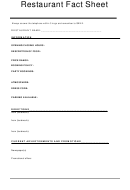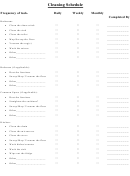Effective Cleaning - Cleaning Schedules
ADVERTISEMENT
Effective Cleaning - Cleaning Schedules
A high standard of cleanliness and regular disinfection is essential to ensure that food is protected from
physical and microbial contamination and to prevent the accumulation of material which would attract pests.
A cleaning schedule will help to ensure a good standard of cleanliness and will also help to maintain
standards cost effectively through correct use of cleaning and disinfectant/bacterial agents.
A cleaning schedule is aimed at monitoring the effectiveness of routine cleaning and staff should still
maintain the practice of ‘cleaning as they go’. Cleaning schedules are a method of supporting this practice,
not replacing it.
Any proposed cleaning schedule should be discussed with appropriate members of staff and then confirmed
in written form so that staff can refer to as and when necessary.
The schedule will specify:-
1.
What is to be cleaned - i.e. floors, walls, ceilings, doors, ventilation canopies, work surfaces
(including sinks, taps and crockery drying racks), equipment (including chopping boards,
refrigerators, mincers, pots), utensils and laundry (including drying up cloths and overalls).
2.
When it is to be cleaned - i.e. monthly, weekly, daily, between shifts, after each use etc.
3.
How it is to be cleaned - i.e. the chemicals (e.g. bactericidal detergent, disinfectant) and their
dilutions, materials (e.g. scrubbing brush, scourer, dishcloth) and equipment to be used ( e.g. steam
cleaner, floor cleaning machine) and how equipment is to be dismantled.
4.
The precautions to be taken - i.e. disconnect equipment from its electrical supply, use cleaning
materials according to manufacturer’s instructions and wear protective equipment ( e.g. rubber
gloves, overalls, eye protection).
5.
Who is to clean it? - Either by name or position.
6.
Who will be responsible for ensuring that cleaning tasks have been completed.
7.
Where cleaning materials and protective equipment is stored and who to report to when stocks are
running low.
You may find that your supplier of cleaning chemicals/ materials may be able to assist you in the provision
of a card index system specifying procedures and precautions. Checklists can also be used to ensure the
work has been carried out to the correct standard and proper frequency. They may also be essential in
establishing a due diligence defence in the event of a complaint.
The following four pages give an example of how a cleaning schedule may be set out with a summary sheet
and checklists for daily, weekly and monthly cleaning.
ADVERTISEMENT
0 votes
Related Articles
Related forms
Related Categories
Parent category: Business
 1
1 2
2 3
3 4
4 5
5 6
6








